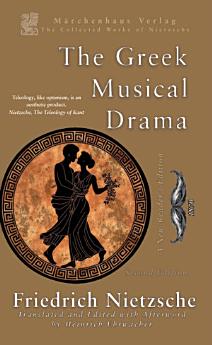The Greek Musical Drama: A New Reader's Edition
May 2024 · The Collected Works of Friedrich Nietzsche Book 14 · Marchen Press
Ebook
116
Pages
family_home
Eligible
info
reportRatings and reviews aren’t verified Learn More
About this ebook
This lecture is one of his first musings on the Apollonian-Dionysian relationship in the creation of Art. Nietzsche's early essay displays a love of Wagner, Schopenhauer and Pre-Socratic philosophy, much like Heidegger. The original German title of this lecture is "Das griechische Musikdrama". This is one of three major Basel lectures he gave immediately after accepting a position at the University of Basel. At the young age of 24, Nietzsche accepted a professorship in philology in 1869, which facilitated his acquaintance with the composer, who lived in Tribschen. During this period, Nietzsche gave three lectures that foreshadowed his future focus: "The Greek Musical Drama" on January 18, "Socrates and Tragedy" on February 1, and "The Dionysian Worldview" in July/August 1870. Feeling constrained by philological topics, Nietzsche sought a professorship in philosophy. His writing reflects influences from two major sources: the philosophy of Schopenhauer and the musical and theoretical works of Wagner. Wagner's influence is particularly sharp here, as this lecture is essentially contrasting Wagner's ideas about the “Gesamtkunstwerk” ( or "total work of art") which integrates all artistic disciplines into a single, cohesive performance, against Schopenhauer's Pessimistic view of life. Art, the full synthesis of all types of art, becomes an antidote to this chaos. The Greek Musical Drama was given by the newly appointed Professor Nietzsche on January 18, 1870 in the Basel Museum and subsequently published by the foundation administered by his sister. This lecture was first published in the volume "Gesammelte Werke" edited by Peter Gast (a pseudonym for Heinrich Köselitz, a close associate of Nietzsche) and Elisabeth Förster-Nietzsche (Nietzsche's sister). They were included in the second series of these collected works under the title "Philologica", published in 1897. This new, modern translation from the original manuscript is designed to allow the armchair philosopher to engage deeply with Nietzsche's works. The language is modern and clean, with simplified sentence structures and diction to make Nietzsche's complex language and arguments as accessible as possible. This critical reader's edition presents a modern translation of the original manuscript, crafted to help the armchair philosopher engage deeply with Nietzsche's works through clean, contemporary language and simplified sentence structures that clarify his complex ideas. Supplementary material enriches the text with autobiographical, historical, and linguistic context, including an afterword by the translator on Nietzsche’s history, impact, and intellectual legacy, an index of the philosophical concepts he employs—emphasizing Existentialism and Phenomenology—a comprehensive chronological list of his published writings, and a detailed timeline of his life, highlighting the personal relationships that shaped his philosophy.
About the author
Friedrich Nietzsche (1844-1900) was a watershed German philosopher, cultural critic, poet, musician (briefly) and philologist (the study of ancient manuscripts) whose work has had a profound impact on modern intellectual history. Known for his critiques of European morality and religion (particularly Protestantism), Nietzsche's ideas on the "will to power" and the "Übermensch" have influenced a wide range of philosophical, literary, and psychological thought including thinkers such as Martin Heidegger, Albert Camus, Michael Foucault and the entire Postmodern religion.
Rate this ebook
Tell us what you think.
Reading information
Smartphones and tablets
Install the Google Play Books app for Android and iPad/iPhone. It syncs automatically with your account and allows you to read online or offline wherever you are.
Laptops and computers
You can listen to audiobooks purchased on Google Play using your computer's web browser.
eReaders and other devices
To read on e-ink devices like Kobo eReaders, you'll need to download a file and transfer it to your device. Follow the detailed Help Center instructions to transfer the files to supported eReaders.











